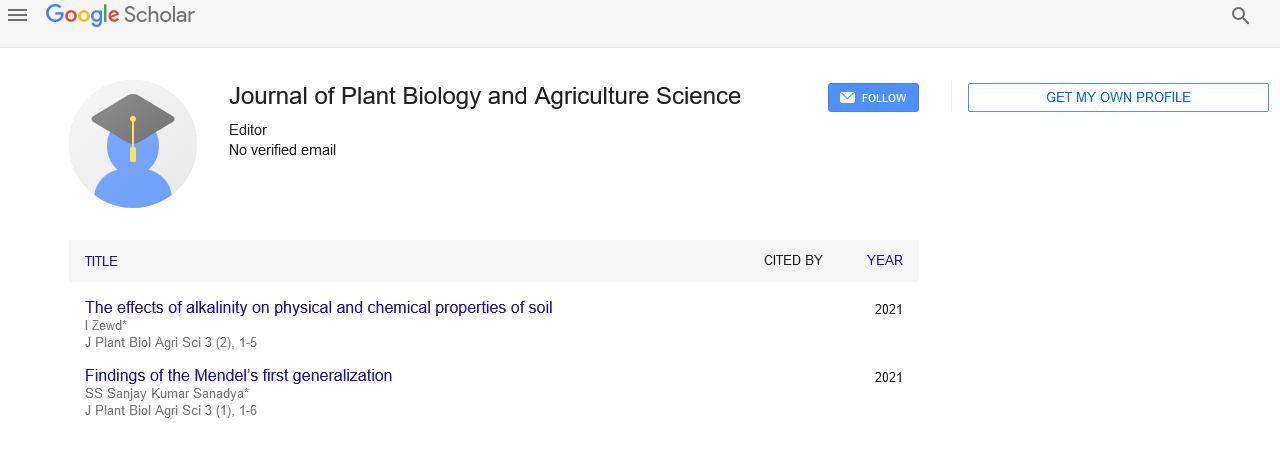Agriculture: Its scope and techniques
Received: 07-Jul-2022, Manuscript No. puljpbas-22-5704; Editor assigned: 09-Jul-2022, Pre QC No. puljpbas-22-5704(PQ); Accepted Date: Aug 05, 2022; Reviewed: 22-Jul-2022 QC No. puljpbas-22-5704(Q); Revised: 29-Jul-2022, Manuscript No. puljpbas-22-5704(R); Published: 06-Aug-2022, DOI: 10.37532/puljpbas.2022.4(4).1-2
Citation: Miller S. Agriculture: Its scope and techniques J Plant Biol Agric Sci. 2022;4(4):1-2.
This open-access article is distributed under the terms of the Creative Commons Attribution Non-Commercial License (CC BY-NC) (http://creativecommons.org/licenses/by-nc/4.0/), which permits reuse, distribution and reproduction of the article, provided that the original work is properly cited and the reuse is restricted to noncommercial purposes. For commercial reuse, contact reprints@pulsus.com
Abstract
The art of raising plants and animals called farming. The cultivation of domesticated species produced food surpluses that allowed people to live in cities, and farming was the crucial development in the creation of stationary human civilization. Agribusiness has a long and illustrious history dating back thousands of years. Beginning ranchers began to plant wild grains around 11,500 years ago after first gathering them starting at least 105,000 years ago. 10,000 years ago, pigs, sheep, and cattle were domesticated. There were at least 11 places in the world where plants may be grown freely
Introduction
Even though 2 billion people still relied on subsistence agriculture in the twentieth century, mechanical horticulture based on largescale monoculture eventually started to overwhelm rural produce. The main agricultural products can be generically categorized into foods, fibres, powers, and raw materials (such as elastic). Cereals (grains), vegetables, natural goods, oils, meat, fish, dairy products, eggs, and organisms are all included in the nutrition classes.
the origin and scope
The words "horticulture" and "agricultura" come from the Latin words "ager" and "cultura," which mean "field" and "cultivation" or "growth," respectively. Agribusiness typically refers to human activities, although some ant, termite, and creepy crawly species have been cultivating crops for up to 60 million years. Agribusiness is defined as using common resources to "provide commodities which keep life up, counting nourishment, fibre, woods products, agricultural crops, and their linked services" in its broadest definition. As such, it includes cultivating arable land, growing creatures, cultivating plants, and providing ranger services, though the latter two are typically left off.
alteration of crops and biotechnology
Since the dawn of civilization, humans has been engaging in the practice of body modification. Crops are modified through breeding, which modifies a plant's genetic makeup to produce crops with more beneficial traits for people, such as larger natural products or seeds, drought tolerance, or pest resistance. Following the work of geneticist Gregor Mendel, significant advances in plant breeding were made. Despite being initially largely disregarded for nearly 50 years, his work on dominant and passive alleles offered plant growers a much better understanding of hereditary traits and breeding techniques. Trim breeding uses techniques including selecting plants with desirable traits, self-pollination and cross-pollination, and atomic tactics that heritably modify the organism.
Genetic Modifications
Genetically Modified Organisms (GMOs) are living things whose genetic makeup has been altered through techniques commonly referred to as recombinant DNA invention. Breeders now have more qualities at their disposal to use in creating desired germlines for contemporary crops thanks to hereditary designing. A few of the traits grown into crops by genetic engineering include increased toughness, wholesomeness, creepy-crawly and infection resistance, and herbicide resistance. GMO crops raise issues for certain people regarding food safety and food labelling. Different countries have imposed restrictions on the production, impact, or use of GMO foods and crops. Currently, the Biosafety Protocol, an international agreement, governs the exchange of GMOs. There is growing discussion on the labelling of foods containing GMOs, however the US does not currently require the labelling of GMO foods, unlike the EU. Herbicide-resistant seeds have a trait built into their DNA that enables the plants to withstand exposure to herbicides.
pesticides
Pesticide use has increased since 1950 million to 2.5 million short tons annually worldwide, while editor harm from annoyances has stayed fairly constant. In 1992, the World Health Organization estimated that 3 million pesticide poisonings annually result in 220,000 fatalities. Pesticides encourage pesticide resistance in the population, leading to a situation known as the "pesticide treadmill" where pesticide resistance justifies the usage of an old pesticide. A common argument is that using pesticides and engaging in extremely high yield farming is the best way to "spare the environment" and prevent starvation, as evidenced by the statement on the website of the Center for Worldwide Nutrition Issues: "Growing more per section of land takes off more arrival for nature." However, experts argue that there need not always be a trade-off between the environment and the need for food, and that pesticides can effectively replace important agronomic techniques like trim rotation.





